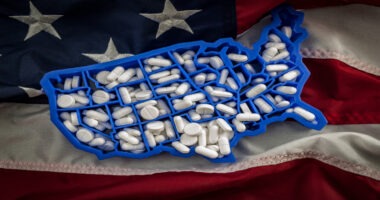From Molecule to Market: The Top 10 Harbingers of Change for the Pharma Industry
From the use of real-world evidence to support the regulation of medicine to the continued rise of niche therapeutics, to increased use of mobile health and telehealth, what are the harbingers for healthcare transformation arising in 2018?
A new report by IQVIA (formerly QuintilesIMS) offers 10 predictions that it says will transform healthcare costs and spending, drug development and delivery, and approaches to determine the societal value of medicines.
10 predictions for change
The study, 2018 and Beyond: Outlook and Turning Points, by the IQVIA Institute for Human Data Science analyzes several healthcare trends in which stakeholders and decision makers are increasingly using real-world evidence and technology to solve the problems of human health. “This report focuses on the most recent real-world evidence and analysis to balance emotion and intuition that can sometimes overshadow critical healthcare decisions,” said Murray Aitken, IQVIA Senior Vice President and Executive Director of the IQVIA Institute for Human Data Science, in commenting on the report. “Based on that analysis, we’re convinced these evidence-based predictions will begin to come to pass later this year.”
1. FDA to guide the use of real-world evidence (RWE) to support regulation of medicines. In 2018, IQVIA predicts that the US Food and Drug Administration (FDA) will issue its first framework addressing the potential for RWE to support regulatory submissions and drug-safety monitoring. “As Big Data gathered in real-world healthcare settings becomes more prevalent and robust, it is increasingly being used across the entire healthcare system for evidentiary purposes,” it said in the report. “With this shift, regulators will be both enabled and challenged to accelerate the pace of their review through new data-derived protocols, insights, and approaches. It’s expected that this evidence, paired with existing clinical trial data, will foster more collaborative approaches between life-sciences companies and the FDA around areas such as trial design and post-market surveillance.”
2. Niche biotherapeutics move toward the mainstream. IQVIA projects that from 2018 through 2022, between five to eight new therapies will launch each year within a new generation of cell-based therapies, gene therapies, and regenerative medicines. Referring to it as a wave of “next-generation biotherapeutics” the report says these therapies “will stretch the definition of a ‘drug’ as we know it.” The report points out that these therapies offer both opportunities and challenges. “Some are engineered for individual patients while others transform previously untreatable or chronic diseases with curative results in a single dose,” notes the report. “Others upend spending paradigms because they carry an extremely high cost per patient relative to traditional therapies. Providing access to these clinical advances will be a challenge for governments and insurers without methods to determine which patients are eligible for treatments, payments based on outcomes, or ability to spread costs over time.
3. Mobile health apps will be added to treatment guidelines. IQVIA predicts that treatment guidelines from major clinical organizations will adopt and recommend the use of mobile health apps this year with some already having done so. It says that the trend toward developing and publishing hard evidence of the value of digital tools and interventions will continue with more than 3,500 studies expected through 2022. “The emergence of well-designed apps and mobile devices has paralleled the development of rigorous clinical trial evidence supporting their value,” says the report. “As mobile apps are better integrated into provider workflows and supported by payer reimbursement, adoption will expand further. These advances offer the potential to improve outcomes for patients sometimes at near-zero incremental costs. While alignment on the appropriate sets of features and safeguards has taken time to develop, there is growing consensus and technology innovators are advancing into the field in significant numbers.”
4. Use of telehealth will expand. The IQVIA report projects that nearly every privately insured patient in the US will have some form of access to telehealth this year although few will use it. In 2018, it projects that telehealth visits will account for 3% to 3.5% of visits, up from 2.6% in 2017. It projects that over the next five years telehealth will grow between 4% and 7.5% of visits as patient concerns about being treated by a random doctor are outweighed by the lower copayments offered by their insurers. “Advocates of telehealth argue that most of the reasons to see a provider in person can be supported remotely,” the report explains. “For payers, concerns about measurable benefits and/or potential fraud are being addressed by technology and are outweighed by cost savings relative to inappropriate use of emergency or urgent care.
5. Spending on branded medicines will decline. In 2018, net brand spending will decline in developed markets by 1% to 3%, according to the IQVIA analysis, which will have the effect of reducing net spending overall on brands in developed markets by approximately $5 billion, to a total of $391 billion for this year. IQVIA projects that net brand spending will remain flat in the next five years despite the expected entry of new branded medicines. “The overall impact on payers, however, should be the same in 2022 for brands as it was in 2017,” says the study. “Manufacturers will continue to develop and launch drugs, but the inherent unpredictability of medicines spending will drive continued caution among payers regarding reimbursement and access.”
6. Specialty brands will drive growth in developed markets. In 2018, the $318 billion specialty medicines market will represent 41% of developed-market spending, up from $172 billion in 2013, according to the IQVIA analysis. It says that specialty drugs will contribute all of the growth in medicine spending in 2018; however, those increases will be offset by spending declines in traditional therapies. The study projects that the growth of spending on specialty medicines will be constrained by cost and access controls and a greater focus on assessments of value. Despite these trends, specialty brands are expected to reach 48% of total spending in developed markets by 2022, according to the IQVIA analysis.
7. Slower growth across pharmerging markets. IQVIA projects that growth in “pharmerging” markets, defined by IQVIA as low-income countries with high pharmaceutical growth, will slow to 7% to 8% in 2018, down from the 9.7% compound annual growth rate over the prior five years. This will mark the third year that growth will be less than 10%. The IQVIA Institute for Human Data Science defines pharmerging countries as those with per capita income below $30,000 and a five-year aggregate pharmaceutical growth of more than $1 billion. The share of global medicine spending from pharmerging markets rose from 13% in 2007 to 24% in 2017. The markets within these pharmerging countries are projected to grow by 6% to 9% to $345 billion to $375 billion by 2022, driven by volume changes and the use of generics, according to the IQVIA analysis. “Overall, the progress of advancing global health will continue, but the gains in access to medicine over the past decade will not continue at the same pace due to slowing economic growth within this key group of countries,” says the report.
8. US net per-capita spending will stabilize. IQVIA projects that real net per-capita spending on medicines in the US will decline in 2018 and continue almost unchanged at roughly $800 per person through 2022. Spending will remain flat after factoring in the pipeline of new drugs, moderating brand price increases of 2% to 5% on a net basis (7% to 10% on a list price basis) and the impact of brand losses of exclusivity, which will be greater in the next five years than the last five, according to the IQVIA analysis. “While setting prices freely has been a unique feature of the US market compared to other countries, the leverage payers have to negotiate net price discounts is effectively offsetting price increases,” asserts the report.
9. Outcomes-based contracts will play limited role. The IQVIA report explains that the basic framework for an outcomes-based contract contains a payment schedule based on how well a drug does or doesn’t deliver results. The most common approach is for insurers to pay less for a drug if it performs worse than the reported results from its clinical trial for FDA approval and pay more for better results. Under these contracts, successful medicines get covered at full price or for proportionately less based on unsuccessful patient results. “These contracts can drive real savings for payers or providers as well as more predictability for overall costs,” says the report. “As the health system gains a greater comfort with electronic medical records, as well as wider use of RWE, collecting data for these outcome requirements will become easier. However, the administrative burden on all parties will escalate and become prohibitive unless the outcomes are designed to be measurable,” says the report.
10. New wave of biosimilar competition and opportunity emerges. In 2018, $19 billion of current biotech spending in developed markets will have competition from biosimilars for the first time, according to the IQVIA analysis. That amount is significantly greater than the $3 billion in biosimilar revenue that became exposed in 2017, and it adds to the $26 billion already facing competition. The report points out that the new exposure to competition in 2018 is the largest single-year change to date and signals the start of the next large wave of biosimilars. “The benefits of a functioning biosimilar market include expanding access and cost savings across public and private healthcare systems,” says the report. “While overall it appears that the next decade will provide sufficient incentives to encourage biosimilar challengers, the greatest uncertainty around biosimilars is whether all medicines that can be challenged in the next decade will indeed face competition and from how many companies.”







